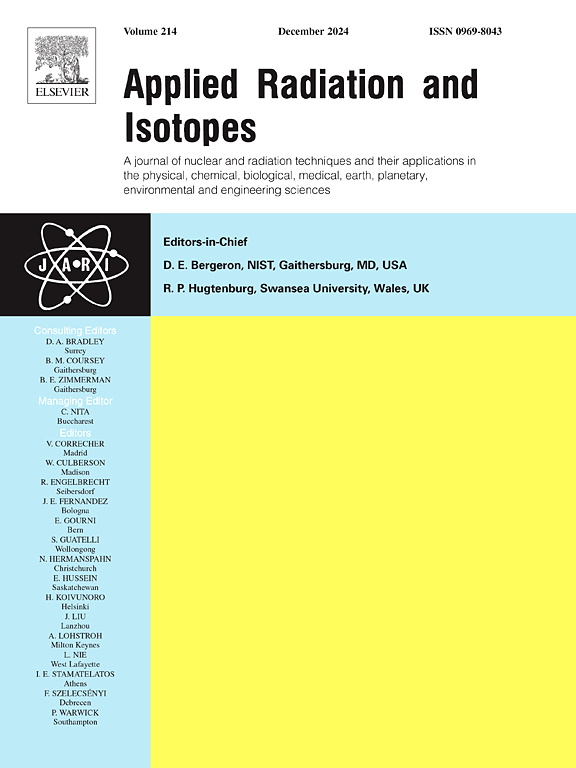Determination of the coincidence summing gamma spectrum of a 60Co source by Monte Carlo simulations taking into account the angular correlation γ - γ
IF 1.6
3区 工程技术
Q3 CHEMISTRY, INORGANIC & NUCLEAR
引用次数: 0
Abstract
The coincidence summing effects can remove counts of the photo-peaks or eventually add spurious counts to them when two photons of lower energy interact simultaneously with the detector. Programs that simulate radiation transport generally do not consider simultaneity effects since they simulate one particle at a time. However, it is possible to obtain the coincidence summing spectrum from the simulated spectrum of the particles of each energy individually. The objective of this work is to develop a method to obtain the coincidence summing spectrum of a radioactive source that emits two (or more) photons in cascade. To do this, we have obtained an exact expression for the coincidence summing spectrum based on the probabilities of interaction with the detector of each photon. These probabilities were obtained by MC simulation and from them, the coincidence summing spectrum was obtained by convolution between them. To make the calculation more consistent with the real phenomenon we have taken into account the angular correlation between the photons. Although the method is applied to a source, the methodology is valid for the case of volumetric sources of different sizes and shapes and the generalization to the case of sources that emit three or more photons in their decay is immediate.
考虑到角相关γ - γ,用蒙特卡罗模拟确定60Co源的符合和γ谱
当两个能量较低的光子同时与探测器相互作用时,巧合和效应可以去除光峰的计数,或者最终增加虚假的计数。模拟辐射输运的程序通常不考虑同时效应,因为它们一次模拟一个粒子。然而,可以从每个能量的粒子的模拟谱中分别获得重合和谱。本工作的目的是开发一种方法来获得两个(或更多)光子级联发射的放射源的重合和谱。为此,我们根据每个光子与探测器相互作用的概率,得到了符合和谱的精确表达式。通过MC模拟得到这些概率,并对它们进行卷积得到符合和谱。为了使计算更符合实际现象,我们考虑了光子之间的角相关性。虽然该方法适用于60Co源,但该方法适用于不同尺寸和形状的体积源,并且可以立即推广到在衰变中发射三个或更多光子的源的情况。
本文章由计算机程序翻译,如有差异,请以英文原文为准。
求助全文
约1分钟内获得全文
求助全文
来源期刊

Applied Radiation and Isotopes
工程技术-核科学技术
CiteScore
3.00
自引率
12.50%
发文量
406
审稿时长
13.5 months
期刊介绍:
Applied Radiation and Isotopes provides a high quality medium for the publication of substantial, original and scientific and technological papers on the development and peaceful application of nuclear, radiation and radionuclide techniques in chemistry, physics, biochemistry, biology, medicine, security, engineering and in the earth, planetary and environmental sciences, all including dosimetry. Nuclear techniques are defined in the broadest sense and both experimental and theoretical papers are welcome. They include the development and use of α- and β-particles, X-rays and γ-rays, neutrons and other nuclear particles and radiations from all sources, including radionuclides, synchrotron sources, cyclotrons and reactors and from the natural environment.
The journal aims to publish papers with significance to an international audience, containing substantial novelty and scientific impact. The Editors reserve the rights to reject, with or without external review, papers that do not meet these criteria.
Papers dealing with radiation processing, i.e., where radiation is used to bring about a biological, chemical or physical change in a material, should be directed to our sister journal Radiation Physics and Chemistry.
 求助内容:
求助内容: 应助结果提醒方式:
应助结果提醒方式:


